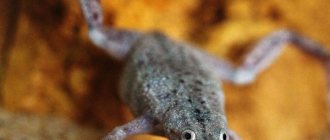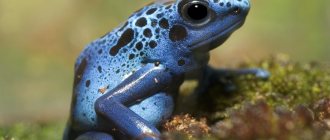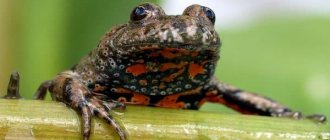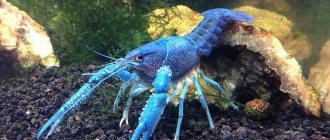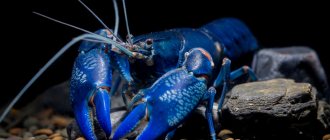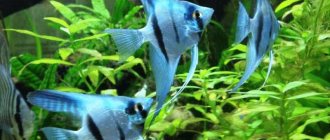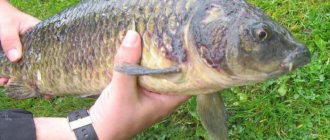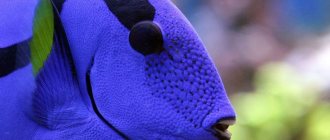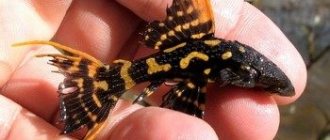Very often in nature, external charm is combined with danger. Animals with their bright colors do not always strive to attract the attention of the opposite sex. In most cases, this is a warning to enemies. This effect is common mainly in amphibians, for example, in poisonous frogs, whose bright colors literally amaze the eye with their beauty.
Quite often, the bright colors of amphibians indicate their toxicity and danger.
Description
The blue dart frog (lat. Dendrobates tinctorius azureus) is a tailless amphibian of the dart frog family (Dendrobatidae). The subspecies are currently not studied.
The body length of the blue dart frog is 3.5-4.5 cm. Males are shorter than females by about 0.5 cm. Weight is 3-6 grams.
The size of frogs in natural conditions is 3.5-4.5 cm
Life expectancy in the wild is 7 years, in a terrarium – 10-12 years.
Terrarists often call them azureus, as well as azure poison dart frogs.
The species is listed in the International Red Book.
Varieties
There are at least 175 varieties of brightly colored tree frogs. However, only 3 of them pose a mortal danger to humans. Other amphibians are not poisonous; with the help of their distinctive color they protect themselves from predators. Those tree nymphs that can actually cause death prefer solitude; they gather in groups only during the mating season, when they reach the age of 2 years. They attack large animals only if they sense danger. They strive to protect their home.
Habitat
The habitat of the blue dart frog is a small area of the Sipaliwini River in South America. This site is located in the south of Suriname and borders Brazil and French Guiana.
Frogs live in the rainforests of South and Central America
Azureus prefer tropical rain forests with rocky soil at altitudes up to 400 m above sea level. They live in dense thickets or under piles of fallen leaves near lakes or puddles. The temperature there during the day ranges from 22° to 27°C, and at night - 20°C.
Due to its very small range, Dendrobates azureus is on the verge of extinction. The main reason is deforestation by surrounding residents.
Spotted dart frog
The family of tailless amphibians called dart frogs is distinguished by a large number of poisonous representatives. For example, the spotted dart frog, which is also known as the dye frog, stands out among them. In nature, they can be of various colors, but any variant of them is very dangerous for humans.
The spotted poison dart frog can be seen mainly during the daytime in tropical forests. They prefer the lower tiers in the territories of Guyana, French Guiana, Brazil and Suriname. In terms of body shape and size, the spotted poison dart frog does not differ from ordinary large frogs. As a rule, females are larger than males, their maximum size can reach eight centimeters.
The color of the spotted dart frog depends on its subspecies. For example, there are Citronellas, the back and sides of which are painted bright yellow, and the rest of the body is black or blue . At the same time, the color of the animal can change for a variety of reasons, ranging from the color of the soil to the mood of Citronella.
The skin of spotted dart frogs contains batrachotoxin alkaloids. If they reach the human body, they will have the most negative impact on the state of the cardiovascular system, even to cardiac arrest. It is believed that the poisonous substance accumulates in the poison dart frog's body due to eating ants and mites. It is used by Indians to create wind weapons.
If the poison simply gets on a person’s skin, then it does not pose a serious danger. In this case, a burning sensation is felt and a slight headache may occur. Despite their toxicity, spotted poison dart frogs are actively grown at home due to their beautiful appearance and behavioral characteristics.
Appearance
The blue dart frog is one of the most beautiful frogs of this species. Its color changes under different lighting from blue to bright blue. The entire surface of the body is covered with black round spots of different sizes.
The azure dart frog is considered one of the most beautiful representatives of this species of amphibians
The pattern on the body of each individual is unique. In the wild, such a warning bright color scares away natural enemies from the blue poison dart frog.
Each foot without swimming membranes has 4 fingers, at the ends of which there are triangular disks with suction cups for easy climbing of trees. The first finger is shorter than the second. Males have longer fingers than females and the tips are heart-shaped.
Azureus do not have teeth, but have a long, notched tongue that is not secured by a frenulum. The pupil of the eyes is transverse, oval. The auditory canal is covered by the eardrum.
Characteristics
Most often, tree frogs are brightly colored. The standard color is a green back with emerald tints, and a milky belly. Along the sides there is a stripe, which can be either black or gray-brown, or stand out as a bright spot on a plain body.
In fact, the color directly depends on what type of poison dart frog we are talking about. There are individuals with bright blue, acid yellow and even spotted bodies. Amphibians acquire colors with age. Tadpoles are born inconspicuously brown. Color may vary depending on environmental conditions. For example, if it gets colder, the tree frog's back will become darker.
The tree frog received the name “tree nymph” for its unusual slenderness and elegance. The amphibian lives in the dense crown of plants, in the shade of bushes. In any case, the tree frog lives near bodies of water. The tree nymph is a small amphibian, most often its body length is only 5–7 cm, but some representatives reach a length of 40 cm. They are considered record holders of their kind. Males are significantly smaller in size than females.
Since frogs are cold-blooded creatures, their body temperature directly depends on environmental conditions. As soon as the air temperature drops to a critical level, tree frogs burrow underground and enter a kind of hibernation, or a state of suspended animation. Some representatives of tree nymphs are capable of spending 7 years without water, burying themselves in the desert sands. These include the Australian frog.
Behavior
Blue dart frogs in the wild coexist on land in mixed groups of up to 60 individuals. They lead a daily lifestyle. They walk almost all day, alternately moving their paws, and less often jump on the forest floor in search of food.
Dart frogs lead an active daily lifestyle
Males protect the areas occupied by their “harem”. They use sounds to inform opponents about this. And if their territory is encroached upon, they furiously try to push the invader out of it.
Their fights are similar to freestyle wrestling. The male, who is defeated, bows his head to the ground. It happens that fights end in the death of an opponent due to broken limbs.
Singing
Tenacious paws with suction cups, bright colors, a long sticky tongue and excellent dexterity are the characteristics of tree frogs. How else can you determine that you are dealing with a tree frog? The clear “voice” of the amphibian will help with this. The fact is that in her throat there is a resonator with an unusual structure. At the same time, in other species of frogs it is located on the sides of the head. Thanks to this feature, the tree frog sings loudly and loudly, thereby notifying everyone around about the arrival of spring.
At those moments when amphibians sing, the skin on their neck resembles a convex ball. The sounds produced during this process are often compared to the quack of ducklings. Males are considered the best artists among representatives of this species. Their jaw skin is golden in color. Singing is also used to attract females. Representatives of each species make special sounds, so only relatives respond to the call. Mating occurs in water. First, the female lays the eggs, and then the male fertilizes them. Soon the tree frog tadpoles emerge. In 50 - 100 days they turn into adults, and after two years they reach sexual maturity.
Poisonous or not
The venom of the blue dart frog in nature is not as strong as that of the terrible leaf climber, one of the representatives of the Dendrobatidae family.
The Tiriyo Indian tribes from the tropical forests of the Sipaliwini savannah smear arrows with the poisonous secretion of Azureus when they hunt small animals.
Under natural conditions, frogs accumulate poison by eating poisonous ants. It is released from a huge number of glands when the skin of an amphibian is touched. The poisonous secretion protects it from fungi and bacteria, as well as from enemies in natural conditions.
Interesting Facts
You should know that not all dart frogs are poisonous. Many have bright colors - a common frightening imitation.
The venom of small amphibians is not used to obtain food. They hunt, like the familiar swamp frogs, with the help of their tongue. The size of the prey can be very different - the main thing is that the insect fits into the mouth.
A brightly colored frog (you can see photos of them in the article) moves along the trunks, branches and leaves of trees thanks to special devices on the pads of its feet. They secrete a sticky substance that can hold an amphibian on any, even the most slippery, surface.
In captivity, colorful frogs can live up to seven years, which is quite a long time for such small representatives of amphibians. If ideal conditions are created, their life can be extended to ten years.
Maintenance and care
Blue dart frogs are unpretentious amphibians. They quickly get used to their new habitat and spend almost the entire day actively moving around in the terrarium. Frogs behave most actively if the air humidity in the terrarium is high, as if “after rain.”
Dart frogs have excellent adaptive abilities and quickly get used to living conditions in captivity
Azureus wake up early in the morning (5-6 am), when it is dark. And in the evening, while it is still light, they hide in shelters and sleep there until the morning.
Azure dart frogs have extremely sensitive skin. Excessive touching should be avoided. To catch them from the terrarium, you should use a container.
Breeding at home
No matter how strange it may sound, modern exotic lovers are increasingly choosing poisonous amphibians as pets. Which is not at all surprising, because huge terrariums with colorful frogs sitting among lush vegetation are not only pleasing to the eye, but also resemble a piece of the jungle.
Modern exotic lovers are increasingly choosing poisonous amphibians as pets.
And, most importantly, keeping such an amphibian at home is absolutely safe, since in an artificial environment it completely loses its poisonous qualities. This is primarily affected by changes in the diet and living conditions of the amphibian.
The most popular terrarium frogs today are dart frogs. The main advantages of these amphibians:
- easy care;
- the diversity and beauty of the frog;
- small sizes;
- Dart frogs are completely comfortable at room temperature;
- even same-sex individuals get along well in the same terrarium;
- have interesting behavior.
Terrarium for an amphibian
Dart frogs are kept in horizontal terrariums with moderate humidity and good ventilation. The dimensions of such a “house” must first of all be selected based on the size of the terrarium vegetation, which these frogs absolutely need. For example, 2-3 pairs of individuals will feel great on an area measuring 60 by 60 cm with a wall height of about 50-70 cm.
Medium or coarse gravel can be used as soil. It is very important that the stones are constantly slightly moistened, so they must be sprayed with settled water once a day.
Medium or coarse gravel can be used as soil for frogs.
Room temperature from + 22 to + 27 °C is perfect for dart frogs, but at night it can be lowered to +18 °C. Such conditions are quite sufficient for the normal life of both amphibians and terrarium plants. Since poison dart frogs are diurnal amphibians, special attention should be paid to lighting: frogs should be provided with good light for 12 hours.
In addition, amphibians vitally need ultraviolet light, so it is very important that the terrarium is equipped with such a device. In no case should you use special heating lamps designed for reptiles (especially desert lizards and turtles), since in strong light the delicate skin of amphibians simply burns.
Amphibians vitally need ultraviolet light, so it is very important that the terrarium is equipped
Low varieties with large leaves, such as tradescantia and various representatives of bromeliads, are well suited for vegetation. A thick piece of driftwood or a small part of a tree trunk is also required. A constant supply of fresh water is extremely important, which is recommended to be kept in a coconut shell.
Nutrition and reproduction
Experienced breeders traditionally feed poison dart frogs with fruit flies, the favorite delicacy of these frogs. However, a novice owner of amphibians may have some difficulties with such “food” (flies have the not very pleasant feature of scattering throughout the apartment), so at the initial stage the frogs can be fed with caterpillar larvae or springtails.
The transformation of a tadpole into a frog is a long process that will take 2-3 months.
Dart frogs reach sexual maturity at about one year of age. After fertilization, females lay a very small number of eggs (only 3-5 pieces) in various shelters. After approximately 20-25 days, small tadpoles appear and are immediately transferred to a small plastic container with clean water. The young are fed with the usual mixture for fry of aquarium fish. The transformation of a tadpole into a frog is a rather long process, which will take 2-3 months.
Thus, even very dangerous and deadly frogs can turn into cute apartment pets, delighting their owner every day with their funny behavior and beauty.
https://youtube.com/watch?v=wpWei7ryjAQ
Diseases
Dart frogs are rather gentle creatures, and therefore, when kept in terrariums, they are often susceptible to diseases such as:
- dropsy,
- intestinal obstruction,
- pneumonia;
- blood poisoning;
- infectious pathologies;
- mycosis;
- rotting of bone and cartilage tissue;
- salmonellosis.
Many of these diseases are difficult to treat and therefore deadly. Experts and veterinarians recommend strictly following the regimen and diet of azure dart frogs, as well as the basic conditions for keeping pets, non-compliance with which often causes diseases.
Be sure to contact your veterinarian if you notice any symptoms of the disease.
If alarming symptoms are detected in an amphibian, you should immediately contact a veterinarian
Red frog
This family of frogs, like poisonous leaf climbers, is an example of how beauty and death can combine. Another of its representatives is the red poison frog, which was first described only in 2011. It lives in the jungles of Nicaragua, Panama and Costa Rica. The body, which is 1.5 cm long, is colored in a red-orange or strawberry palette. The hind legs are bright blue, and there are black markings on the head and back. The tree frog is the second most dangerous creature in the world after the yellow poison frog.
Price and where to buy
Due to the small population, it is not very easy to acquire poison dart frog. You are unlikely to find it in a regular pet store. But it is possible to order on a specialized website. It is important to contact a trusted seller.
The price will depend on the age of the dart frog and the regional location of the buyer. You can buy a baby blue dart frog for about 2000-2500 rubles. A female up to 1 year old can be bought for 5,000 rubles.
Blue dart frogs are spectacular, bright, unusual frogs that will decorate any terrarium.
Dart frogs are beautiful and unusual frogs that will become a worthy decoration for any terrarium.
Such beauties can be given names, because it is easy to distinguish them thanks to the individuality of color. Given the right conditions, these amazing amphibians will delight and amuse the owner for many years.
Are you interested in the blue dart frog? Or maybe you kept such a pet in an aquarium? Share your opinion and experience in the comments.
I
The tree frog can be poisonous. Therefore, sometimes bright coloring is not just a beautiful appearance, but also a warning that it is better not to mess with the amphibian. Amphibians secrete a poisonous toxin. Its victim can be paralyzed, stunned or even killed. Some representatives of amphibians are considered among the most dangerous creatures on the planet.
The American aborigines, commonly called Amerindians, have benefited from the deadly poison for many centuries. When hunting, they use darts whose tips are lubricated with a deadly substance. To collect the poison, they pierced the frog and held it over the fire for some time. The drops that appeared on her skin were collected in a separate container. Arrowheads were dropped there. Because of this, representatives of tree frogs began to be called dart frogs.
